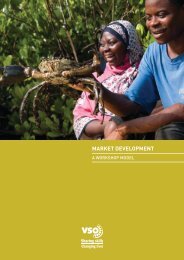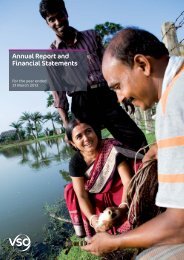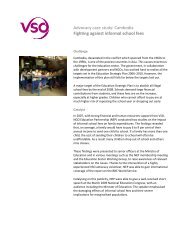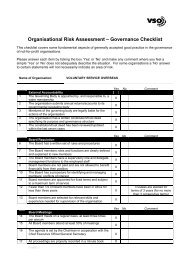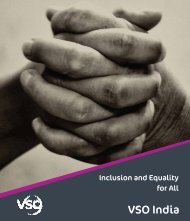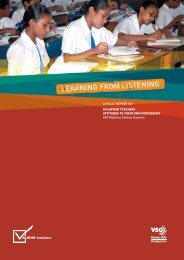Teachers' Voice â Nigeria - VSO
Teachers' Voice â Nigeria - VSO
Teachers' Voice â Nigeria - VSO
- No tags were found...
You also want an ePaper? Increase the reach of your titles
YUMPU automatically turns print PDFs into web optimized ePapers that Google loves.
5.3.4 THE ROLE OF HEAD TEACHERS: RECOMMENDATIONS<strong>VSO</strong> recommends the following:• Head teachers must get management training as soon as they are appointed – to both staff andschool management skills• The LGEA should ensure the position of head teacher is part of the teacher careerdevelopment path.• SUBEBs should therefore offer management training to all teachers interested in amanagement career.• SUBEBs should insist that only experienced teachers with the required qualifications and skillsshould qualify for promotion to head teacher. Newly appointed head teachers should be givena probation period of at least one year. Once they have proved themselves as head teacher, theirposition should be made permanent.• Head teachers must have enough admin support staff for the required paperwork to free themto provide professional support to their teachers.• Clear guidelines on head teachers’ roles and responsibilities must be put in place by theSUBEBs and LGEAs.• In accordance with these guidelines, head teachers must call regular staff meetings, andteacher–parent meetings to address current issues and to develop school plans and budgets.• Head teachers are answerable to their staff about the actions they take on behalf of the schooland individual teachers, and must not allow personal affiliations and political interest toinfluence their performance or decisions.• Head teachers must support the advice of teachers and should never question their decisionsin public.5.4 TEACHER NUMBERS5.4.1 TEACHER NUMBERS: POLICY FRAMEWORKThe official policy is that teachers are recruited on the basis of student numbers. Studentnumbers are collected from head teachers by the Planning, Research and Statistic Departmentof SUBEB, with the aid of LGEAs, and teachers are allocated to schools according to thoseenrolment numbers.5.4.2 TEACHER NUMBERS: TEACHERS’ VIEWS“We used to have at least one teacher in every classroom, often we had two. But thelast few years we have had to combine classes. So you will find all grades 1 up to 6 arein one room, but it also happens that we have to combine grades 1 and 2 or 3 and 4because some of us have stayed at home, or have been transferred.”(Teacher)The reality is a shortage of teachers, particularly in rural areas, where teachers are reluctant to workdue to lack of amenities and incentives. In addition, teachers observe a lack of qualified teachers.The shortage of teachers is leading to multi-grade teaching in addition to teacher fatigue, as theyare teaching large numbers. The pupil–teacher ratio has been 100 to 1; this is frustrating on itsown and leads to low morale.5.4.3 TEACHER NUMBERS: STAKEHOLDERS’ VIEWSNumerous stakeholders identify the shortage of teachers as a major hindrance to the deliveryof quality education. They see it as the cause of overcrowded classrooms, increased use ofcorporal punishment, poor pupil teacher relationships and, therefore, as a major source ofstress for teachers and children.In an effort to mitigate the effects of teacher shortages the states recruit unqualified teachers.Stakeholders are concerned by the fact that states are still employing so many unqualifiedteachers. They commend the efforts of the FME to employ and dispatch 40,000 NCE-qualified32




